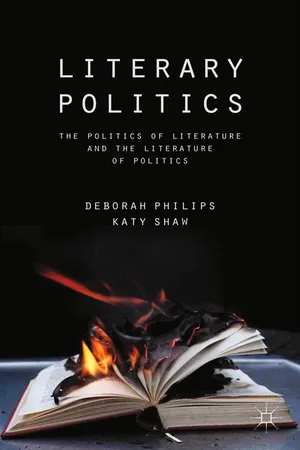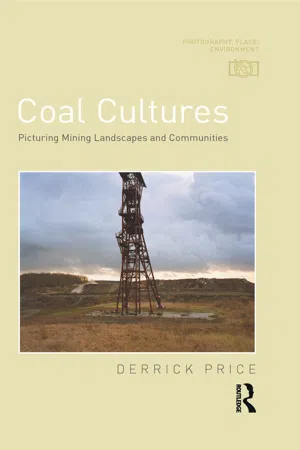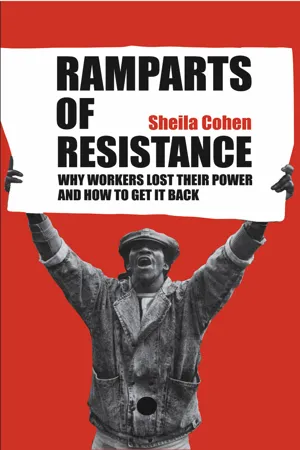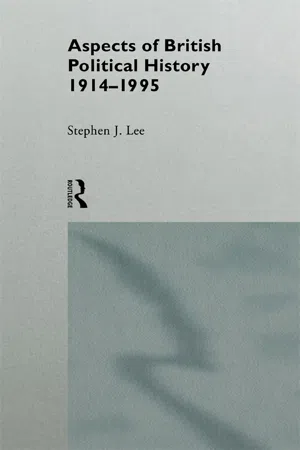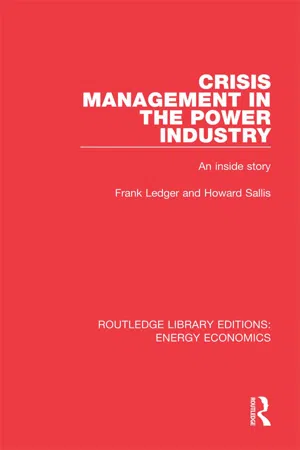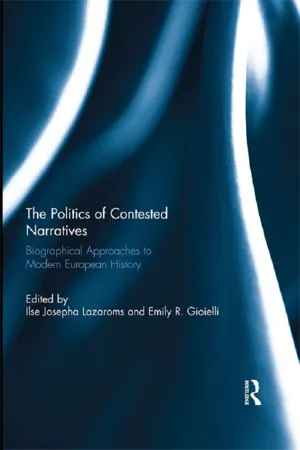History
Miners' Strike
The Miners' Strike refers to a major industrial action that took place in the UK from 1984 to 1985. It was a confrontation between the National Union of Mineworkers and the Conservative government over proposed pit closures and the future of the coal industry. The strike had significant social, economic, and political implications, and its legacy continues to be felt in British society.
Written by Perlego with AI-assistance
Related key terms
1 of 5
6 Key excerpts on "Miners' Strike"
- eBook - ePub
Literary Politics
The Politics of Literature and the Literature of Politics
- D. Philips, K. Shaw, D. Philips, K. Shaw(Authors)
- 2013(Publication Date)
- Palgrave Macmillan(Publisher)
9 (Re)Writing the 1984–1985 UK Miners’ Strike Katy ShawThe UK miners’ strike of 1984–1985 was a defining moment in the history of the United Kingdom, one that not only illuminates the country’s near-history, but functions as a prism through which to understand the social, political and economic challenges of the twenty-first century. More than twenty-five years on, the strike remains a profound focus of cultural, social and political interest because its legacies are as much about the future of the United Kingdom as its past. From cultures of worklessness and social damage, to the role of regional development agencies and community initiatives, the 1984–1985 UK miners’ strike was instrumental in establishing a range of discourses that came to define the subsequent decades.As the most divisive dispute in our recent history, the 1984–1985 miners’ strike remains a spectre that continues to haunt our contemporary world. Just under the surface of recent events, 1984–1985 is with us still. For a generation of readers born in the ‘Cool Britannia’ of 1990s New Labour, there is a new motivation to look back to the Conservative legacy that bore the political conditions of the present day, to re-examine decades of unrest, division and disquiet both at home and abroad. Since the turn of the millennium, the Thatcher years have become a particularly popular period to reappraise as a result of the global credit crunch. The economic downturn that defined the first decade of the new millennium was relayed by a Western media eager to mobilise the boom and bust, recession and unemployment discourses of the 1970s and 1980s, making the politics of the recent past a more immediate, relatable and felt presence. This chapter will explore the insights offered and challenges faced in illuminating the relationship between literature and politics and the political significance of literary form using some examples of key texts from the heart of the Thatcher years: Tony Harrison’s infamous poem ‘V. - eBook - ePub
Coal Cultures
Picturing Mining Landscapes and Communities
- Derrick Price(Author)
- 2020(Publication Date)
- Routledge(Publisher)
The Soviet miners’ strike of 1991 helped to change the course of Russian history as the miners supported Boris Yeltsin, and one of their chief demands was the resignation of President Gorbachev. However, this strike marked the apex of working class action in that country and later the miners saw a decline in their living standards and the gradual erosion of their industry. No strike stands as a single event. Each brings with it a particular set of demands and involves political struggle and community action. They can also involve an entire place and community. Take the 1932 strike in Belgium. At the heart of it was the Borinage region where Van Gogh had lived among the miners and painted them in a series of melancholy images. Here, too, the Dutch-born artist Henry Luyten recorded the strike in his huge painting called ‘The Strike’. The struggle also inspired one of the most famous documentary films of the 1930s: Joris Ivens and Henri Storck’s Misère au Borinage, which looked at the woeful condition of the miners, at evictions, the strike and the relationship of this particular struggle to capitalism as a whole. The film ends with a call for the death of capitalism and the rise of the proletariat. The British miners’ strike of 1984/1985 Many strikes might be discussed, then, each of them of great interest and national importance. I have chosen to write about a few, less for the political positions they exemplify, than for the ways in which they were reported and entered public consciousness. They were represented in film, photography, television, song and literature. Indeed, as we shall see, in one instance a strike was brought back from the amnesia of history by a feature film. On the 23rd of April 2004 John Lichfield reported in The Independent newspaper that ‘the French coal miner, a powerful symbol of social revolt and industrial strength for more than a century, passed into extinction’ - eBook - PDF
Ramparts of Resistance
Why Workers Lost Their Power, and How to Get It Back
- Sheila Cohen(Author)
- 2006(Publication Date)
- Pluto Press(Publisher)
A rail strike began almost immediately after the postal workers’ strike was over, whereas ‘had it coincided with the earlier stoppage, [it] could have blocked the major alternative chan-nel for parcel distribution’. 29 And yet, during the same period, workers mobilised massively to defeat successive governments’ attempts to bring in anti-union leg-islation. Political action and opposition on a grand scale were com-bined with strategic inadequacy and lack of class awareness in a mix that was eventually to lead to defeat in the face of the far more focused attack led by Thatcher. For the moment, though, the period seemed to possess its own irrepressible impetus, a class struggle dynamic seen at its strongest in the legendary ‘Saltley Gates’ and ‘Pentonville Five’ revolts by miners and dockers in 1972. ‘We don’t want your pound notes …’ Despite their historic reputation as working-class leaders, miners had seen their pay decline steadily since the mid 1950s; between 1967 and 1971 they had experienced a 3 per cent cut in real wages. The miners’ anger at their deteriorating position had resulted in two earlier, localised strikes in 1969 and 1970 which had strengthened the left and enabled militants to develop tactics like the famous ‘flying pickets’ commonly credited to Arthur Scargill, though used by a range of activists since the 1940s. 30 In November 1971, miners voted for national action for the first time since 1926; the strike began on 9 January 1972. The militant Yorkshire left of the National Union of Mineworkers, headed by Arthur Scargill, began almost immediately to use flying pickets to block the most vulnerable points of coal production and transport, like power stations, coke and coal depots. Only weeks into the strike, the Yorkshire pickets were drafted into a national effort to stop movements of coal across the country; by early February only three weeks’ supply of coal was left in the power stations. However, The Upsurge: 1968–74 19 - eBook - ePub
- Stephen J. Lee(Author)
- 2005(Publication Date)
- Routledge(Publisher)
In outline, British miners were in dispute with the mineowners who, in 1925, proposed to increase working hours and reduce wages to make the coal industry more competitive. Baldwin's Conservative government tried to prevent a conflict by providing a nine-month subsidy to maintain the existing level of wages; at the same time it appointed the Samuel Commission to propose a longer-term solution. In March 1926 the Commission recommended the ending of the subsidy, along with the introduction of temporary wage cuts until the owners could reorganise the mines more effectively. This was rejected by the owners, who announced a unilateral reduction of wages in April 1926. The miners resisted and appealed to the Trades Union Congress (TUC) for support. The TUC negotiated with the government to try to avert a general strike, which it was prepared to call, if necessary, to back the miners’ cause. When these negotiations broke down between 2 and 3 May, the TUC General Council called out transport and railway workers, printers, gas and electricity workers, and those employed in heavy industry. The remaining workers were to follow in due course. The government, in the meantime, had taken special precautions to combat the effects of the strike. These proved so effective that on 12 May the TUC decided to end the General Strike and accept the Samuel Memorandum. This was, however, rejected by the miners, who were left to fight alone until the end of the year, when the threat of starvation forced them back to work.This chapter deals with three main issues related to the events of 1925– 6. Why did Britain fall over the brink into a general strike in the first place? What was the range of views within the country concerning the strike and the strikers? And what was the significance of the General Strike in the short and longer terms?THE REASONS FOR THE GENERAL STRIKE
Four separate strands have to be disentangled before a full perspective can emerge on the reasons for the General Strike. One is the underlying state of the economy with the contraction of the basic industries and the consequent growth of unemployment and social hardship. The second is the specific impact of such conditions on the coal industry, which suffered more severely than any other. The third is the crisis which developed within the coal industry as the two sides—pit owners and miners— pursued aims which proved irreconcilable. The fourth, and most critical, is the policy pursued by the government to deal with this confrontation.The General Strike occurred during a period of painful economic adjustment. This was due partly to the shrinking of the staple industries such as coal, steel, textiles and heavy engineering which, before the First World War, had accounted for over 50 per cent of Britain's industrial output and 70 per cent of her exports. These continued after 1919 to take up most of Britain's resources and investment, even though they were becoming increasingly inefficient. Little was done to improve or modernise production techniques, in the way that was taking place in the United States and Germany, and the need for urgent readjustment was clouded by the illusion of security created by being on the winning side in the First World War. The problem was compounded by Britain's return to the gold standard in 1925, which inflated the price of exports by about 10 per cent, and by the growing pressure exerted within Britain by the growth of newer and more efficient industries like electricity and gas. As heavy industry became less and less competitive there was a strong tendency to blame lack of productivity on the level of wages, making industrial conflict more and more likely. - eBook - ePub
Crisis Management in the Power Industry
An Inside Story
- Frank Ledger, Howard Sallis(Authors)
- 2017(Publication Date)
- Taylor & Francis(Publisher)
Part IIThe miners’ strike 1984–5
This part tells the compelling story of the miners’ strike of 1984–5, doing so for the first time from the standpoint of the CEGB whose strength and resourcefulness were strained almost to their limits. Keeping the lights on was a statutory duty of the Board, not a weapon in a political battle, a distinction which the board strove to maintain at every stage of this bitter conflict. Yet nobody could doubt that failure to maintain supplies would have changed the course of history. The story concludes with the return of the miners to work with nothing to show for their struggles, with the CEGB returning to normal, and the industry and the nation beginning to count the cost.Note: In parts II and III the word ‘we’ is used frequently in the account of the 1984–5 miners’ strike. It can refer either to the CEGB senior management team of which one of the joint authors was a member or the broader CEGB organisation, depending on the context. In many cases it is not possible to name a single individual who carried out an action since most events involved a wide range of people at all levels and it is convenient to refer to the group as ‘we’.Passage contains an image
Chapter 8
Conflict in context
This chapter is not intended to deal with the immediate causes of the 1984–5 miners’ strike. Rather, it is concerned with the political, economic and industrial relations background which, indirectly rather than directly, helped to determine the attitudes of the NCB, CEGB, NUM and others who were either involved face-to-face or were drawn, in spite of themselves, into the conflict. The account starts towards the end of 1977 where it was left at the end of Chapter 7 - eBook - ePub
The Politics of Contested Narratives
Biographical Approaches to Modern European History
- Ilse Lazaroms, Emily Gioielli, Ilse Josepha Lazaroms, Emily R. Gioielli(Authors)
- 2016(Publication Date)
- Routledge(Publisher)
Leisure, Citizenship and Working-Class Men in Britain, 1850-1945. Manchester: Manchester University Press, 2005.Beckett, Francis and David Hencke. Marching to the Fault Line: The Miners’ Strike and the Battle for Industrial Britain. London: Constable, 2009.Beddoe, Deirdre. Out of the Shadows: A History of Women in Twentieth-Century Wales. Cardiff: University of Wales Press, 2000.Brooke, Stephen. “Gender and Working-Class Identity in Britain during the 1950s.” Journal of Social History 34 (2001): 773–95.Bruley, Sue. The Women and Men of 1926: A Gender and Social History of the General Strike and Miners’ Lockout in South Wales. Cardiff: University of Wales Press, 2010.Burge, Alun. “In Search of Harry Blount: Scabbing between the Wars in one South Wales Community.” Llafur 6 (1994): 58–69.Cook, Matt. “Twentieth-Century Masculinities.” Journal of Contemporary History 43 (2008): 127–35.Curtis, Ben. The South Wales Miners, 1964-1985, Unpublished PhD Thesis: University of Glamorgan 2007.Davies, Rebecca Elizabeth. “Not Supporting But Leading”: The Involvement of the Women of the South Wales Coalfield in the 1984-1985 Miners’ Strike, 2010 Unpublished PhD Thesis: University of Glamorgan.Edwards, Ness. History of the South Wales Miners’ Federation: Volume I. London: Lawrence & Wishart, 1938.Evans, Jill, C. Hudson, and P. Smith. “Women & the Miners: It’s a Whole Way of Life.” Radical Wales 6 (1985): 14–15.Francis, Hywel. Miners Against Fascism: Wales and the Spanish Civil War. London: Lawrence & Wishart, 1984.——. “The Law, Oral Tradition, and the Mining Community.” Journal of Law and Society 12 (1985): 267–71.——. History on our Side: Wales and the 1984-85 Miners’ Strike. Ferry Side: Iconau, 2009.——, and David Smith. The Fed: A History of the South Wales Miners in the Twentieth Century. London: Lawrence & Wishart, 1980.——, and Gareth Rees. “‘No Surrender in the Valleys’: The 1984-85 Miners’ Strike in South Wales.” Llafur 5, no. 2 (1989): 41–71.Isaac, Ian. When We Were Miners. Carmarthen: Ken Smith Press, 2010.Gier-Viskovatoff, J. Jaclyn and Abigail Porter. “Women of the British Coalfields on Strike in 1926 and 1984: Documenting Lives Using Oral History and Photography.” Frontiers: A Journal of Women Studies
Index pages curate the most relevant extracts from our library of academic textbooks. They’ve been created using an in-house natural language model (NLM), each adding context and meaning to key research topics.
